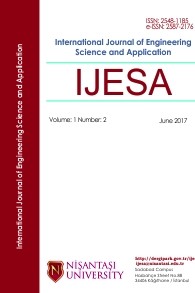A Hybrid Genetic-Ant Colony Algorithm for Travelling Salesman Problem
A Hybrid Genetic-Ant Colony Algorithm for Travelling Salesman Problem
Ant colony algorithm, Genetic algorithm Path planning, Hybrid genetic-ant colony algorithm,
___
- S. Koziel and X.-S. Yang, Computational optimization, methods and algorithms, vol. 356. Springer, 2011.
- M. Mitchell, An Introduction to genetic algorithms. MIT Press, 1998.
- J. Kennedy and R. Eberhart, “Particle swarm optimization,” Neural Networks, 1995. Proceedings., IEEE Int. Conf., vol. 4, pp. 1942–1948 vol.4, 1995.
- M. Dorigo, M. Birattari, and T. Stutzle, “Ant colony optimization,” IEEE Comput. Intell. Mag., vol. 1, no. 4, pp. 28–39, 2006.
- A. Mucherino, O. Seref, O. Seref, O. E. Kundakcioglu, and P. Pardalos, “Monkey search: a novel metaheuristic search for global optimization,” in AIP conference proceedings, 2007, vol. 953, no. 1, pp. 162–173.
- C. Yang, X. Tu, and J. Chen, “Algorithm of marriage in honey bees optimization based on the wolf pack search,” Proc. 2007 Int. Conf. Intell. Pervasive Comput. IPC 2007, pp. 462–467, 2007.
- X.-S. Yang and S. Deb, “Cuckoo search via Lévy flights,” in Nature & Biologically Inspired Computing, 2009. NaBIC 2009. World Congress on, 2009, pp. 210–214.
- W. Pan, “Knowledge-Based Systems A new Fruit Fly Optimization Algorithm : Taking the financial distress model as an example,” Knowledge-Based Syst., vol. 26, pp. 69–74, 2012.
- A. Kaveh and N. Farhoudi, “A new optimization method: Dolphin echolocation,” Adv. Eng. Softw., vol. 59, pp. 53–70, 2013.
- S. Mirjalili and A. Lewis, “The Whale Optimization Algorithm,” Adv. Eng. Softw., vol. 95, pp. 51–67, 2016.
- X. Chen, Y. Kong, X. Fang, and Q. Wu, “A fast two-stage ACO algorithm for robotic path planning,” Neural Comput. Appl., vol. 22, no. 2, pp. 313–319, 2013.
- M. a. P. Garcia, O. Montiel, O. Castillo, R. Sepúlveda, and P. Melin, “Path planning for autonomous mobile robot navigation with ant colony optimization and fuzzy cost function evaluation,” Appl. Soft Comput., vol. 9, no. 3, pp. 1102–1110, 2009.
- J. E. Aghazadeh Heris and M. A. Oskoei, “Modified genetic algorithm for solving n-queens problem,” 2014 Iran. Conf. Intell. Syst., pp. 1–5, 2014.
- A. C. Nearchou, “Path planning of a mobile robot using genetic heuristics,” Robotica, vol. 16, no. 5, pp. 575–588, 1998.
- A. C. Nearchou and N. A. Aspragathos, “A genetic path planning algorithm for redundant articulated robots,” Robotica, vol. 15, no. 2, p. S0263574797000234, Mar. 1997.
- J. Ni, K. Wang, H. Huang, L. Wu, and C. Luo, “Robot path planning based on an improved genetic algorithm with variable length chromosome,” 2016 12th Int. Conf. Nat. Comput. Fuzzy Syst. Knowl. Discov., pp. 145–149, 2016.
- M. S. Saad, H. Jamaluddin, and I. Z. M. Darus, “Implementation of PID controller tuning using differential evolution and genetic algorithms,” Int. J. Innov. Comput. Inf. Control, vol. 8, no. 11, pp. 7761–7779, 2012.
- R. K. Tan and Ş. Bora, “Parameter Tuning Algorithms in Modeling And Simulation,” Int. J. Eng. Sci. Appl., vol. 1, no. 2, pp. 58–66, 2017.
- N. M. Razali and J. Geraghty, “Genetic Algorithm Performance with Different Selection Strategies in Solving TSP,” Int. Conf. Comput. Intell. Intell. Syst., 2011.
- ISSN: 2548-1185
- Başlangıç: 2016
- Yayıncı: Nişantaşı Üniversitesi
Exergetic analysis and comparative study of a roughened solar air heater using MATLAB
Programming Encryption Algorithms with Steganography
Enhancement of Long Term Evolution Advanced Performance using Distributed Antenna Systems
Bachar RAHİMA, Golea AMAR, Benchouia M-T
A Hybrid Genetic-Ant Colony Algorithm for Travelling Salesman Problem
